The Use of Negative Pressure Wound Therapy in Patients with Skin Grafts and Flaps-Juniper-Publishers
Juniper Online Journal of Orthopedic & Orthoplastic Surgery
Introduction
Increasing the healing rate of a wound by applying an
externally controlled negative pressure is known as Negative Pressure
Wound Therapy (NPWT). Negative pressure drains serve as an excellent
atmospheric bandage [1,2]
and NPWT can be used for treating wounds which usually take a long time
to heal or do not heal at all when treated using conventional treatment
methods [3] and also diabetic foot disease which has become a major global burden [2]. Though, international organizations have already developed NPWT machines, their cost is around 7 to 8 thousand [4],
which is unbearable to a developing country like India. Increasing
healthcare costs and the growing burden of non-healing wounds is a
challenging issue in India. Due to their high cost, NPWT devices are not
available in Indian civil hospitals [5-7].
As a result, the patients with non-healing wounds
Increases the healthcare cost of the country due to their long stays at
hospitals and suffer changes in their life style. Especially, diabetic
foot amputees lose their legs due to non-healing wounds. A manually
operated low cost NPWT device was therefore developed at our General
Hospital. It has demonstrated the success of the therapy to, many
patients with non healing ulcers, traumatic raw area. In our hospital we
have applied this system to patients operated with split thickness
grafts and flaps. We have observed early take of graft and early
settlement of flaps But one problem identified with this machine is that
it is being operated manually and its inability to maintain pressure at
a regular value, But the desired pressure range in NPWT is -50 to
-175mmHg while the optimal value is -125mmHg [5].
objective of the this research is to develop a reliable, low power
consuming, user friendly, portable and low cost NPWT system to treat
different types of wounds and to Test the system clinically at a plastic
surgery department to Evaluate its performance.
Aims and Objective
a. To study effect of Negative pressure wound therapy on post-operative Outcomes in Patients operated with skin graft and flap.
b. To study impact of negative pressure wound therapy on local infection.
c. To develop a manually operated low cost NPWT device.
d. To study duration of the graft take with use of the device.
Materials and Methods
This study is a single institutional observational
cohort study of Negative Pressure Wound Therapy post operatively for the
purpose of early graft take and early settlement of flap. Data will be
prospectively collected in a standardized fashion. The analyzed
preoperative variables include patient demographics, co morbid
conditions, and laboratory values, culture and sensitivity of wound,
site and condition of wound. After application graft and flap and
application of negative pressure wound therapy patient will be observed
for any local or systemic complication, wound contraction, progress of
graft take length of hospital stay (LOS), wound condition, morbidity
will be assessed [8-10].
Indications for Use
The Negative Pressure Wound Therapy System (NPWT) is
an integrated wound management system for use in acute and extended
settings. It is intended to create an environment that promotes wound
healing by secondary or tertiary (delayed primary) intention by
preparing the wound bed for closure, reducing edema [10], promoting granulation tissue formation and perfusion and by removing exudates and infectious material [11,12].
It is indicated for patients with chronic, acute, traumatic, sub-acute
and dehisced wounds, partial-thickness burns, ulcers (such as diabetic,
pressure or venous insufficiency], flaps and grafts. The Negative
Pressure wound therapy is an effective barrier to bacterial penetration
and may help reduce infection [13,14].
Contraindications
Do not place foam dressings of the Negative Pressure
Wound Therapy System directly in contact with exposed blood vessels,
anastomotic sites, organs, or nerves. Negative Pressure Wound Therapy is
contraindicated for patients with:
a. Malignancy in the wound
b. Untreated osteomyelitis
c. Non-enteric and unexplored fistulas
d. Necrotic tissue with eschar present
e. Vasculitis
f. HIV and HbsAg positive Patients
g. Sensitivity to products used in dressing
After debridement of necrotic tissue and complete removal of eschar, Negative Pressure Wound Therapy may be used.
Mechanism of Action
The Negative Pressure Wound Therapy is the first
active, non-invasive wound care product, used by a secure local
regulated sub-atmospheric pressure technique.
The exact mechanisms to explain this treatment are not known yet. Researches by Argenta et al. [12,13]
postulated that interrelated factors are the basis for the success of
the technique. These factors can be devised in 3 subgroups:
Removing
Tissues surrounding the chronic wounds are
characterized by localized collection of interstitial or third-space
fluid. This third space fluid or edema caused by increased capillary
permeability in wound. Wound cell and nourishment of wound decrease due
to Edema fluid oxygenation. This collection of third-space fluid
contains factors which inhibits or suppresses mitosis, protein synthesis
and fibroblasts collagen synthesis. An active withdrawal of this fluid
removes the excess of third space wound fluid and its inhibitory
factors. The active withdrawal also results in the removing of wound
debris.
Improving
The collection of third space fluid mechanically
compromises the micro-vascularisation and lymphatic system. By removing
the third space fluid and its inhibitory factors, this result in
increased vascularisation, reduced venous after load and an increased
delivery of oxygen and nutrients as well. These changes improve the rate
of granulation formation and the concentration of growth factors. An
additional mechanism of the Negetive Pressure Wound Therapy is the
mechanical stimulation of cells migration by tensile forces placed on
the surrounding tissues [10].
Adequate wound perfusion essential for tissue repair. Blood supply
required for delivery of cells, factors & elements like Platelets,
Neutrophils, Monocytes, Nutrients, and Oxygen etc. Peripheral blood
supply essential for wound healing processes to continue. It Helps fight
infection and Delivers oxygen & nutrients for healing [11,12,13].
Reducing
Besides reducing of third space fluid, We know that
successful wound healing correlates with bacterial counts of less than
1,00,000 organism per gram of tissue. Bacterial counts of human wounds
treated by Negative Pressure Wound Therapy have demonstrated a
significant decrease after 3-4 days usually until less than 1000 per
gram of tissue [14,15].
NPWT for Split Thickness Grafts
NPWT has been used instead of traditional bolstering
methods to provide skin graft fixation. Improved qualitative skin graft
take and quantitative improvement in skin graft success (e.g. repeat
grafts) have been described in observational studies and two randomized
trials [16,21]. Moisidis E & Heath T, et al. [17]
conducted a trial in which 60 patients are randomly assigned to NPWT
dressing connected to An aspiration to NPWT dressing connected to
aspiration system versus NPWT dressing not connected to an aspiration
system after STSG. NPWT was associated with significant reduction in
graft loss.
1. Loss of graft area: zero versus 4.5cm2 in control group
2. Median duration of hospital stay: 13.5 versus 17 days
In our study, median duration of hospital stay was 11
days for split thickness skin graft with NPWT. Median duration of
hospital stay was 13 days for flaps. Moisidis and colleagues compared a
standard bolster dressing with an NPWT dressing, although quantitative
graft take was similar between two groups but NPWT significantly
improved the qualitative appearance of the graft.
NPWT for Flaps
The usefulness of NPWT over vascularised flaps is
controversial. Morgan and colleagues specifically reported that NPWT
does not increase the risk of flap failure rates or complication.
However NPWT has also been shown to reduce tissue edema and improve
venous congestion and contouring of flaps all of which consider
beneficial. Eisenhardt, et al. [18]
specifically reported that NPWT does not increase the risk of flap
failure rates or complication. In our study there was reduction of
tissue edema and there is no flap failure with NPWT.
Discussion
In the present study of Use of Negative Pressure
Wound Therapy in Post-operative Patients with Skin Grafts and Flaps, 30
cases admitted in our ward were studied. Maximum (90.0%) numbers of
patients in this study were males. Most of the patients admitted with
soft tissue defect were suffered from road traffic accident and Most of
the populations in road traffic accidents are males (Figure 1).
In our study maximum number of population was between age group of 40
to 60 years (30%), followed by young population between 10 to 20 years
(20%) and 20 to 30 years (20%). Least number of patients is above 60
years of age (Figure 2).
Causes aft raw area and soft tissue defect in our study was road
traffic accident (73.33%) followed by post cellulites raw area (13.33%),
post operative dehisced flaps (6.66%) and chronic ulcers (6.66%) (Figure 3).
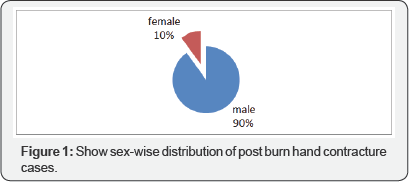
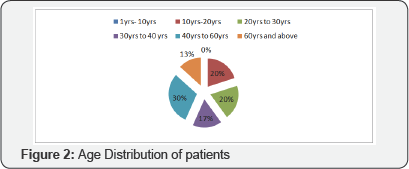
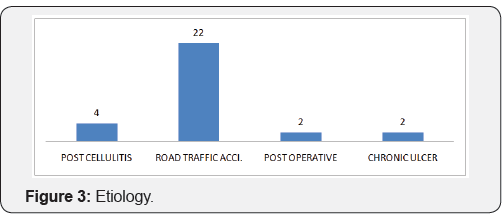
Maximum numbers of patient were having less than 50cm2 (70%) area for application of negative pressure wound therapy Five patients are having surface area of 50 to 100cm2. There are three patients with size more than 200 cm2 and one patient with size between 100 to 200cm2 (Figure 4).
In our study 63% patients are having good amount of healthy granulation
over wound most of which achieved by pre operative application of
negative pressure wound therapy. 36% patients are having unhealthy
granulation tissue (Figure 5). 93.33% Patients treated with gauze application. 6.66% patients treated with presterilised foam application (Figure 6).
Only one patient is having is having graft take less than 70%. 41%
patients are having graft take of a 100%. 29% patients are having graft
take of 95%. Patients having 90% and 80% of graft take are 12.5
percentages each (Figure 7).
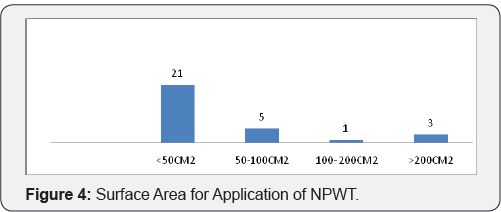
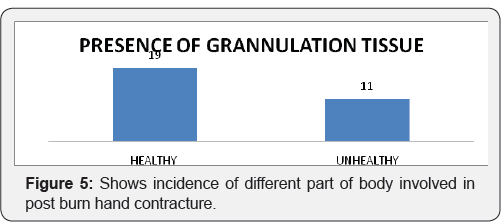
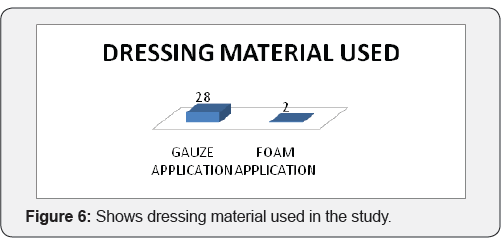
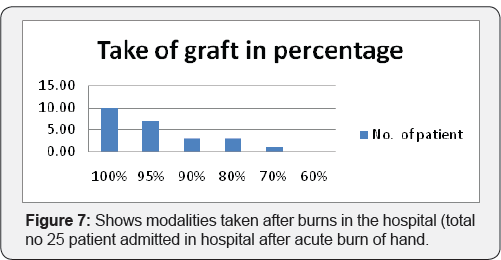

Maximum no. of patient treated with split thickness skin grafting [19]
with excellent results. 3 patients were treated with
transposition flap and application of negative pressure wound therapy to
both transposition flap and adjacent graft, 2 patients were having
gastrocnemius flap for upper third defect of leg. In 2 patients negative
pressure wound therapy applied over reverse surely artery flap after
division and inset. 2 patients are of fillet flap of great toe. In One
patient NPWT applied over groin flap after division and inset and in one
patient NPWT it is applied over abdominal flap after dehiscence of
suture line after division and inset (Figure 8).
1 patient with split thickness skin grafting was having infection in
scar, while 1 patient was having pain over dressing area. One patient
with gastrocnemius flap was having skin rash at edge of flap area which
is managed by daily dressing (Table 1).

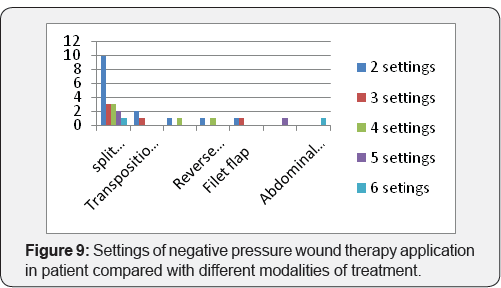
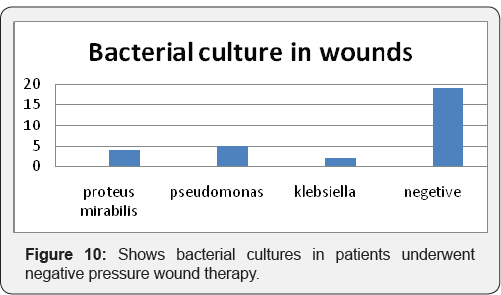
Maximum Patients with split thickness skin grafting
were given 2 settings of negative pressure wound therapy each of 3 days
(50.00%) out of 24 patients (Figure 9).
Out of 30 patients 19 patients (63.33) were having negative culture
reports. 4 patients were having proteus mirabilis (13.33), 5 patients
were having pseudomonas (16.66), 2 patients (6.66%) were having
klebsiella organism in there bacteriological culture. One patient with
pseudomonas culture on raw area shoes graft take of 70%. As end point of
result was complete graft take and flap settlement there is no organism
were found on bacteriological culture (Figure 10).
Out of 19 patients with split thickness graft 16 patients((63.33%) were
treated with intermittent NPWT and 3 patients were treated with
continuous NPWT. 9 patients (81.81%) of flaps treated intermittent NPWT 2
patients were treated with continuous NPWT (Figure 11).
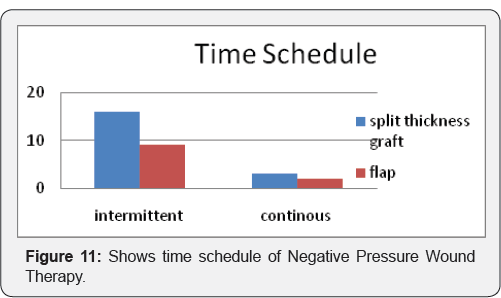
Acute and Chronic wound management represents a
considerable burden on health services and requires considerable
manpower, frequent consultations and adjunct therapies. Chronic wounds
affect patient's ability to function in their environment causing
financial social and psychological consequences as well as affecting
their quality of life [1-6].
Regardless of etiology, wounds are difficult to treat if coexisting
factors (e.g., infection or diabetes mellitus) prevent regular wound
healing [22,23].
Wounds represent a significant risk factor for hospitalization,
amputation, sepsis, and even death, and from the patient's perspective,
wound therapy is often uncomfortable or painful. Topical Negative
pressure devices are believed to hasten the take of graft, removing
wound exudates, increasing local blood flow, provide immobilization of
graft, applying mechanical pressure to promote wound closure and
reducing bacterial load in the wound. In addition to providing an
optimal wound bed environment, topical negative pressure has been shown
to increase local blood flow to the wound site in initial animal
studies. Adequate perfusion is essential to proper take of the graft in
order to provide nutrients and to remove inflammatory mediators to the
wound and to remove local edema. An important factor in wound healing is
the growth of granulation tissue. Initial studies by Morykwas et al. [24,25,26]
showed a significant increase in rate of granulation tissue formation
in wounds treated with NPWT Device compared with control wounds treated
with saline-moistened gauze.
Argenta et al. [22]
reported finding from animal study as well as human clinics trials
showing that a fourfold increase in blood flow levels when 125mmHg
sub-atmospheric pressures was applied. A significantly increased rate of
granulation tissue formation (p<= 0.5) was reported with continuous
(63.3% -/+ 26.1%) and intermittent (103% -/+ 35.3%) application of
negative pressure wound therapy.
Complication
Minimal complication encounters in present study.
Bleeding occurs in one patient with operated case of gastrocnemius flap
with application of NPWT over surface. There is a discontinuation in
application of NPWT in one patient due to excessive pain. One of the
patients with NPWT develops peripheral skin infection leading to
discontinuation of NPWT [23].
Even unethical given the large effects observed in uncontrolled
studies. Clinical and economical importance of NPWT has increased in
recent times because it is an innovative and commercially successful
concept for the management of difficult to treat wound of nearly every
etiology [19,20].
The results of our study showed that indigenous NPWT is an effective
tool in management of Split thickness graft, post surgical dehisced
wounds and flaps. It is cost effective as compared to imported / local
commercial NPWT devices available in the market. Indigenous NPWT is safe
with minimal adverse events.
Results
A. Negative pressure wound therapy is cost effective as compared to commercially available negative pressure wound therapy
B. Negative pressure wound therapy improve quantitative take of graft and decreases hospital stay.
C. Negative pressure wound therapy is useful option on dehisced flap to reduce edema and for early settlement of flap (Figures 12-25)
Case 1
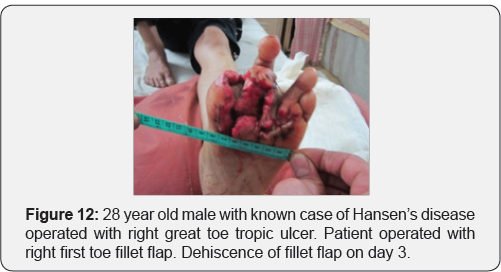
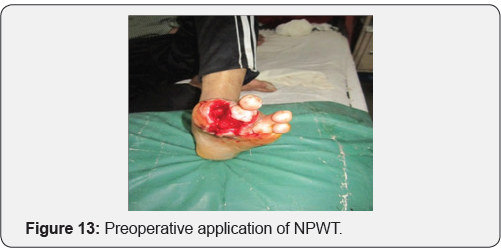
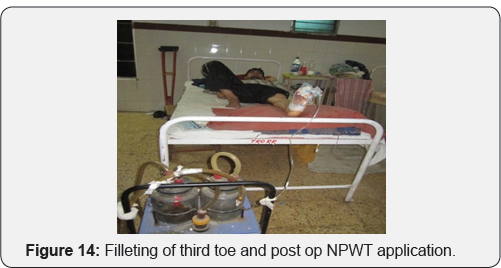
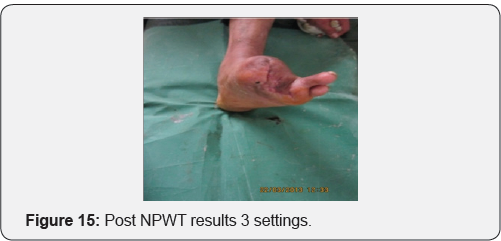
Case 2: 28 year old male with history of post traumatic raw area over dorsum of foot.
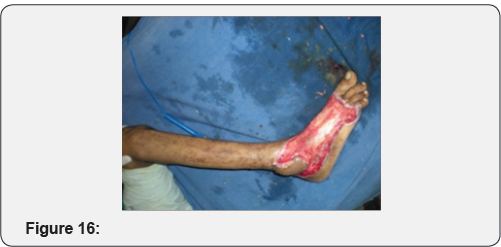
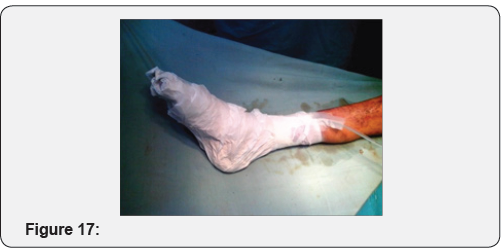


Case 3: Crush injury to right hand due to hand caught in ganna machine.

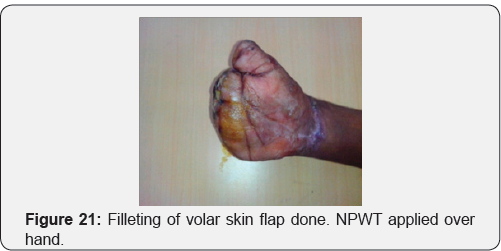

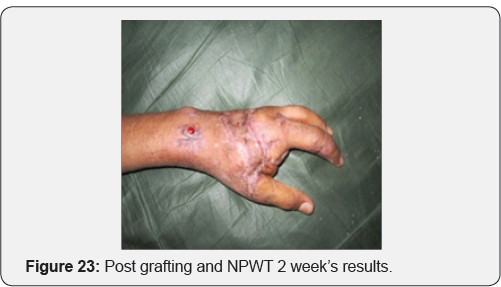
Case 4: Operated case of crush hand injury of right hand with filleting of second and third digit with raw area over dorsum of hand.
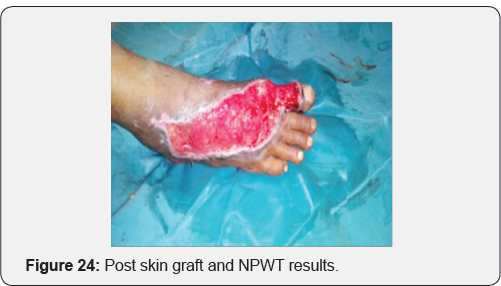
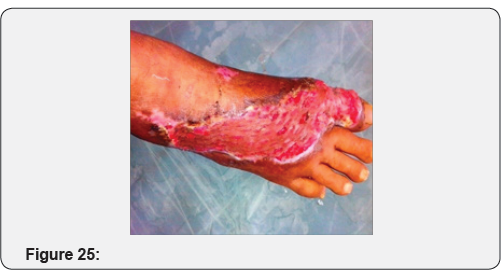
Conflict of Interest
None
To read more articles in Journal of
Orthopedic & Orthoplastic Surgery
To
Know More about Juniper Publishers click
on: https://juniperpublishers.com/


Comments
Post a Comment